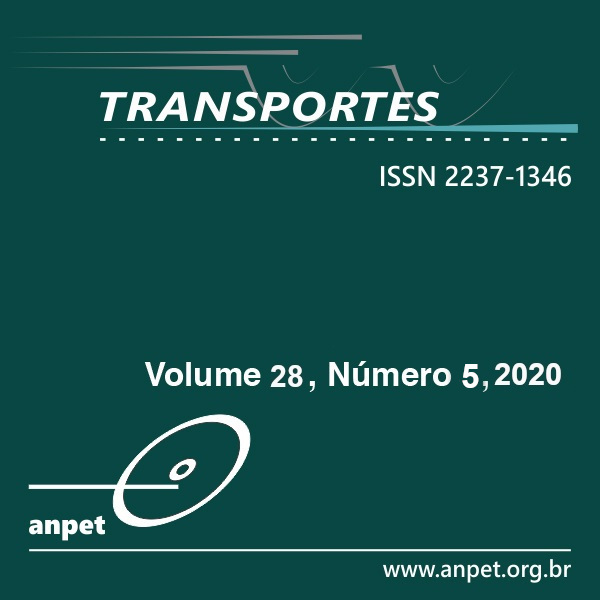Analisando a variabilidade de estimativas de acessibilidade por transporte público a partir de dados de GPS
DOI:
https://doi.org/10.14295/transportes.v28i5.2175Palavras-chave:
Indicadores de acessibilidade. Dados de GTFS. Dados de GPS. Variabilidade no tempo de viagem.Resumo
Acessibilidade é um conceito chave no planejamento integrado dos transportes e uso do solo. Dados de General Transit Feed Specification (GTFS) têm sido usados com sucesso nos últimos anos como insumo na mensuração dos níveis de acessibilidade, mas são baseadas em viagens programadas de transporte público para estimar tempos de viagem entre pares origem-destino. Por outro lado, dados de GPS têm sido aplicados na atualização de tabelas horárias de viagens realizadas, embora com limitações metodológicas e computacionais, baseando-se em medidas de tendência central dos tempos de viagem para recompor o arquivo GTFS. Usando um mês de dados de GPS dos ônibus em Fortaleza, analisou-se a variabilidade da acessibilidade a partir dos tempos de viagem observados, calculados considerando sua dispersão. Os resultados demonstram que há variabilidade significativa na estimação dos indicadores de acessibilidade, tanto no espaço como entre atividades de trabalho e educação, podendo impactar na avaliação de intervenções no sistema de transportes.
Downloads
Referências
Arbex, R. O.; B. B. Alves e M. A. Giannotti (2016) Comparing Accessibility in Urban Slums Using Smart Card and Bus GPS Data. TRB 2016 Annual Meeting, Washington, DC, Estados Unidos.
Arbex, R. O. e C. B. da Cunha (2016) Avaliação das mudanças nas velocidades das linhas de ônibus da cidade de São Paulo após a implantação de faixas exclusivas através da análise de dados de GPS. Transportes, v. 24, n. 4, p. 21. DOI: 10.14295/transportes.v24i4.1008
Farber, S. e L. Fu (2017) Dynamic public transit accessibility using travel time cubes: Comparing the effects of infrastructure (dis)investments over time. Computers, Environment and Urban Systems, v. 62, p. 30–40. DOI: 10.1016/j.compenvurbsys.2016.10.005
Geurs, K. T. e B. van Wee (2004) Accessibility evaluation of land-use and transport strategies: Review and research direc-tions. Journal of Transport Geography, v. 12, n. 2, p. 127–140. DOI: 10.1016/j.jtrangeo.2003.10.005
Hansen, W. G (1959) How Accessibility Shapes Land Use. Journal of the American Planning Association, v. 25, n. 2, p. 73–76. DOI: 10.1080/01944365908978307
IBGE (2019) Estimativas da População Residente no Brasil e Unidades da Federação. Instituto Brasileiro de Geografia e Estatística.
Lei, T. L. e R. L. Church (2010) Mapping transit-based access: Integrating GIS, routes and schedules. International Journal of Geographical Information Science, v. 24, n. 2, p. 283–304. DOI: 10.1080/13658810902835404
Mandelzys, M. e B. Hellinga (2010) Identifying Causes of Performance Issues in Bus Schedule Adherence with Automatic Vehicle Location and Passenger Count Data. Transportation Research Record: Journal of the Transportation Research Board, v. 2143, n. 1, p. 9-15. DOI: 10.3141/2143-02
Mavoa, S.; K. Witten; T. McCreanor e D. O’Sullivan (2012) GIS based destination accessibility via public transit and walking in Auckland, New Zealand. Journal of Transport Geography, v. 20, n. 1, p. 15–22. DOI: 10.1016/j.jtrangeo.2011.10.001
Mayaud, J. R.; M. Tran; R. H. Pereira e R. Nuttall (2018) Future access to essential services in a growing smart city: The case of Surrey, British Columbia. Computers, Environment and Urban Systems, v. 73, p. 1-15. DOI: 10.1016/j.compenvurbsys.2018.07.005
Mazloumi, E.; G. Currie e G. Rose (2010) Using GPS Data to Gain Insight into Public Transport Travel Time Variability. Journal of Transportation Engineering, v. 136, n. 7, p. 623-631. DOI: 10.1061/(ASCE)TE.1943-5436.0000126
Owen, A. e D. M. Levinson (2015) Modeling the commute mode share of transit using continuous accessibility to jobs. Trans-portation Research Part A: Policy and Practice, v. 74, p. 110–122. DOI: 10.1016/j.tra.2015.02.002
Pereira, R. H. (2019) Future accessibility impacts of transport policy scenarios: Equity and sensitivity to travel time thresh-olds for Bus Rapid Transit expansion in Rio de Janeiro. Journal of Transport Geography, v. 74, n. October, p. 321–332. DOI: 10.1016/j.jtrangeo.2018.12.005
Pereira, R. H. M.; C. K. V. Braga; B. Serra e V. Nadalin (2019). Desigualdades socioespaciais de acesso a oportunidades nas cidades brasileiras, 2019. Texto para Discussão Ipea, 2535. Instituto de Pesquisa Econômica Aplicada (Ipea). Disponível em http://repositorio.ipea.gov.br/handle/11058/9586
Stȩpniak, M.; J. P. Pritchard; K. T. Geurs e S. Goliszek (2019) The impact of temporal resolution on public transport accessibil-ity measurement: Review and case study in Poland. Journal of Transport Geography, v. 75, n. January, p. 8–24. DOI: 10.1016/j.jtrangeo.2019.01.007
Tornqvist, L.; P. Vartia e Y. O. Vartia (1985) How Should Relative Changes Be Measured? The American Statistician, v. 39, n. 1, p. 43-46. DOI: 10.2307/2683905
Wessel, N.; J. Allen e S. Farber (2017) Constructing a routable retrospective transit timetable from a real-time vehicle loca-tion feed and GTFS. Journal of Transport Geography, v. 62, n. January, p. 92–97. DOI: 10.1016/j.jtrangeo.2017.04.012
Wessel, N. e S. Farber (2019) On the accuracy of schedule-based GTFS for measuring accessibility. Journal of Transport and Land Use, v. 12, p. 475-500. DOI: 10.5198/jtlu.2019.1502
Downloads
Publicado
Como Citar
Edição
Seção
Licença
Ao submeter um manuscrito para publicação neste periódico, todos os seus autores concordam, antecipada e irrestritamente, com os seguintes termos:
- Os autores mantém os direitos autorais e concedem à Transportes o direito de primeira publicação do manuscrito, sem nenhum ônus financeiro, e abrem mão de qualquer outra remuneração pela sua publicação pela ANPET.
- Ao ser publicado pela Transportes, o manuscrito fica automaticamente licenciado sob a Licença Creative Commons CC BY 4.0. Esta licença permite o seu compartilhamento com reconhecimento da autoria e da publicação inicial neste periódico.
- Os autores têm autorização para assumir contratos adicionais separadamente, para distribuição não exclusiva da versão do trabalho publicada neste periódico (por ex.: publicar em repositório institucional ou como capítulo de livro), com reconhecimento da publicação inicial na Transportes, desde que tal contrato não implique num endosso do conteúdo do manuscrito ou do novo veículo pela ANPET.
- Os autores têm permissão e são estimulados a publicar e distribuir seu manuscrito online (por ex.: em repositórios institucionais ou na sua página pessoal) depois de concluído o processo editorial. Como a Transportes é de acesso livre, os autores são estimulados a usar links para o DOI do artigo nesses casos.
- Os autores garantem que obtiveram todas as permissões necessárias dos empregadores para a publicação e o licenciamento CC BY 4.0 do manuscrito, especialmente se o empregador possuir alguma reivindicação sobre os direitos autorais do manuscrito. Os autores assumem total responsabilidade por questões de direitos autorais relacionadas ao empregador, isentando a ANPET e a Transportes de qualquer responsabilidade relacionada.
- Os autores assumem toda responsabilidade sobre o conteúdo do manuscrito, incluindo as devidas e necessárias autorizações para divulgação de dados coletados e resultados obtidos, isentando a ANPET e a Transportes de toda e qualquer responsabilidade neste sentido.
Última atualização: 27/11/2025











